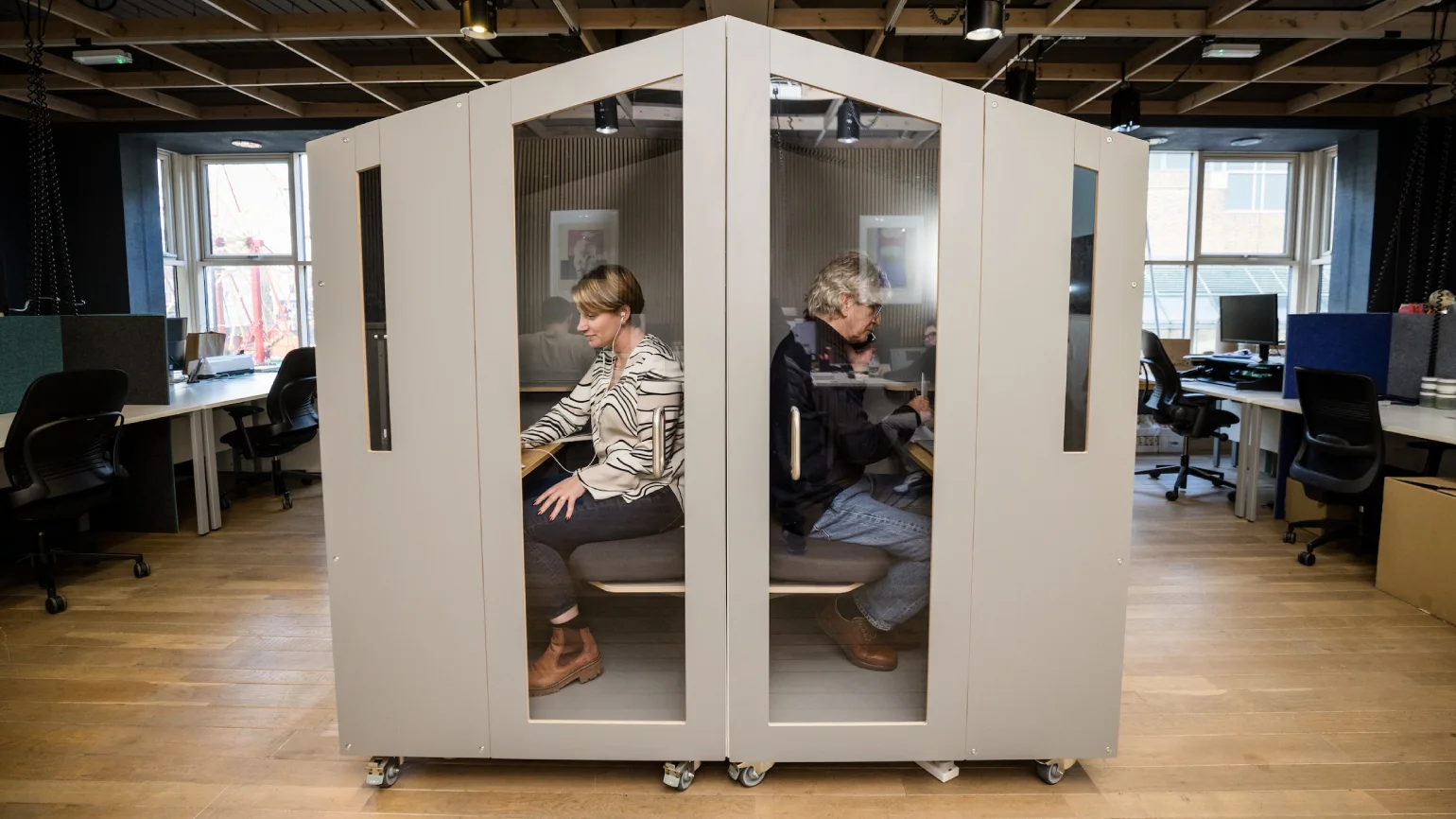
It can be challenging to keep up with the rapidly changing flex industry.
From shifts in product offerings to new coworking concepts and spaces popping up every day, it’s an exciting (and sometimes overwhelming) time to be a coworking owner or operator.
Because we work so closely with coworking leaders globally, we have a unique perspective on the coworking sector and how it’s evolving. With this in mind, we’ll be sharing with you nine coworking trends and things you need to know about when starting a coworking space in 2024.
In this year’s article, we’ll discuss why hospitality is at the forefront of the coworking experience, who the newest coworking members are, and what you need to know about the evolving world of niche coworking and flex spaces here.
It’s worth mentioning that we wrote an article on coworking trends for 2023 for Coworking Resources last year, and many of those trends are on this year’s list as well. That’s because many are still very much relevant and are, in fact, growing in popularity.
Let’s dive in!
1. The coworking sector is growing – and competition is rising
Flexible workspaces, including coworking spaces, account for roughly 2% of the commercial real estate market today. Some analysts predict that by 2030, that number could be as high as 30%.
This is great news for coworking owners and operators looking to take advantage of the growing need for flexible workspaces. But as the coworking industry continues to get more attention, competition will naturally rise in response.
One study out of the UK found that the entrance of larger coworking entities into local markets could present challenges for smaller operators. The research argues that when large coworking companies or actors enter the sector, they force smaller operators to alter their offering to stay competitive.
With so many more coworking spaces popping up around the world, coworking owners and operators need to have an understanding as to how they plan to differentiate themselves and deliver an exceptional experience. Otherwise, they’re likely to face challenges as competition tightens.
Many of our clients opening new coworking spaces are thinking about ways that they can leverage value-add services to stand out in a crowded market. This could include:
- Community specific events and offerings
- Partnerships with local businesses to offer additional perks and discounts
- Unique amenities
A note on competition
It’s important to note that many coworking spaces don’t like to think of themselves as “competitors”. As quoted by Cat Johnson on LinkedIn, “your competition is not each other, it’s people working from their kitchen table.”
With this perspective, you can consider how more coworking spaces entering the market will push you to provide a more exceptional experience for your members, rather than “increase competition” with each other.
Regardless, people have more options when it comes to where and how they work outside of just traditional offices or plain-jane coworking spaces, and this will impact the choices they make.
2. The coworking space demographic has changed

When Brad Neuberg started the first coworking space in San Francisco in 2005, he wanted to combine the freedom and independence of entrepreneurship with the community and structure of working in an office.
For a long time, coworking attracted an audience of entrepreneurs, freelancers, digital nomads, and other solo workers as a result of this vision.
While entrepreneurs and freelancers certainly still make up a large portion of coworking members, there is another audience that is quickly overtaking spaces: remote workers and remote teams.
According to the New York Times, “refugee corporate employees”, ie. those who operate on a remote or hybrid work model, are a primary audience for coworking spaces worldwide. They account for roughly 15% of all coworking members in some spaces.
This is important for coworking owners and operators to understand because it can change what you offer and how you offer them.
Supporting remote employees
Here are some of the most common ways we see the influx of remote employees affecting coworking spaces.
- More remote workers on Zoom calls means a greater need for phone booths and private spaces to take calls throughout the day
- You may need to educate your market, both the corporate employer as well as the employees, on what coworking can offer and its benefits outside of simply providing a desk
- An emphasis on community building elements is important in attracting people out of their homes and into your space
- Creating partnerships with remote organizations is emerging as a viable marketing strategy
Consider how you can tailor aspects of your coworking offering to attract remote workers into your space and capitalize on the growing need for coworking in this specific demographic.
3. Community is more important than ever before
One of the common threads we see amongst coworking spaces that are succeeding today is a strong community.
Community helps to attract and retain members, while creating a unique point of differentiation for your space. It is also one of the few things that coworking owners can offer members that they otherwise wouldn’t get at home.
MIT reported that workplace loneliness is on the rise, even before the pandemic. Even in some of the least lonely work environments, over 50% of people report feeling lonely. Coworking spaces are in a unique position to address issues of workplace loneliness by providing an engaged community to work with.
According to the Harvard Business Review, employees report coworking spaces as being more socially fulfilling than working from the office or the home. People enjoy having the opportunity to speak to and connect with those outside of their immediate coworkers, and find the relationships they develop in coworking spaces to be more satisfying than other work environments.
To cultivate this sense of community, work on bringing people together intentionally be it through virtual meetings, curated events, or casual water cooler chats. You can encourage connection amongst members, new and old, and incorporate opportunities for natural connection throughout the day.
Follow the advice of these nine coworking leaders to better understand how they think about coworking users and begin to build community.
4. Hospitality and experience are a central point of focus

As people look for more out of how they work, hospitality and experience take center stage.
When asked about starting a coworking space, Chris Davies, CEO at Uncommon, said, “I think people need to understand that we are, in many ways, running hotels; we have desks not beds. You will need this hospitality mindset to achieve in this market. I believe this is going to become even more relevant over the next 5 years.”
In speaking to many coworking owners and operators in various locations around the globe, hospitality and creating an exceptional experience for members consistently take center stage.
How to make experience front and center
We often get questions around exactly how to improve the user experience and make a positive impact of the lives of your members (and your business). Some ideas include:
- Creating an effortless experience, from signing-up and onboarding to every touch point a member has with your business going forward
- Paying attention to the details, like furniture design and what kind of coffee you provide
- Reducing friction at important member touch points like payments and bookings
- Providing outstanding customer service, including how you greet members and how you address issues in your space
Essentially, transforming your coworking space from a simple work environment into a delightful and memorable experience should be the goal of new operators. Paying attention to the details and sweating the small stuff is sure to go a long way.
5. People want more from their coworking technology
As discussed in our guest blog for Coworking Insights, while most coworking operators began managing their space with excel spreadsheets and pen and paper, most spaces now have an understanding that technology is essential.
Using technology to effectively manage a coworking space is key to operating at scale. To stay ahead, operators need to think beyond the basics of simply using technology to manage a space. They also need to think about:
- How to create an integrated suite of tools
- Leveraging automation in their day-to-day operations
- Bringing their tools mobile-first
- Personalizing and customizing their technological solutions
Mass adoption of coworking software like Optix and coworking technology like keyless, codeless access control systems is well-understood. Next, it’s about optimizing these technology systems in a way so that they can work more efficiently for you and your community.
In our conversation on the We Run Flex podcast with Bernhard Mehl, CEO at Kisi, he spoke about landlords and real estate operators needing to adopt technology to make their spaces more attractive and more flexible. This innovation will be key in staying ahead in the future. Listen to the full conversation now.
6. Autonomous coworking spaces are on the rise

Some coworking owners and operators are taking technology one step forward to create fully autonomous coworking spaces – that is, spaces that do not have any staff on site.
Creating an autonomous space gives operators more flexibility, while also contributing to the profitability of the space overall.
In these cases, members:
- Sign up for the space and pay for a membership online
- Access the space using an access control system
- Check-in to the space on their mobile device
- Book meeting rooms, dedicated desks, and other resources via coworking software
We are hearing more and more from operators of coworking spaces that they want to be able to manage the space remotely, without needing to be on site everyday. This could be because operators have other jobs and responsibilities or because they simply do not want to be tied to a physical space in their own work.
We can expect to see this trend to continue, as coworking spaces continue to push the boundaries of ingenuity and what is possible with the coworking business model. Read about how to create an autonomous coworking space.
7. Niche coworking spaces are here to stay
We’ve written a number of articles on niche spaces in the last two years, including our most recent article on niche spaces for Coworking Resources. However, there are no signs of this trend slowing down.
As the coworking sector matures, niche spaces are gaining popularity. A niche coworking space is a shared workspace that is designed to fit a specific demographic of the population.
- Coworking + warehousing spaces are designed for owners of physical goods businesses, like consumer product goods.
- Coworking + recording studios are designed for artists and musicians.
- Coworking + medical spaces are designed for doctors.
Niche coworking spaces are a natural consequence of increased competition, increased familiarity with the concept of coworking, and increased desire for community amongst shared demographics.
They offer an easier opportunity for community building, as people already have something in common with their fellow members. They can also help differentiate yourself as a space and attract an engaged audience.
To succeed with a niche coworking space, it’s best to identify the niche and the need for the space in the community first before launching the space. For example, Steve Krueger, Founder at ECOMsqaure, hosted community meet-ups for people in the ecommerce industry before opening a dedicated coworking space to meet the needs of this specific community.
8. The original product offering is shifting

When looking at the history of coworking, the original view was that coworking spaces would serve as predominantly open seating areas where individuals could freely interact and collaborate with one another.
Coworking popularized the “hot desk”, an on-demand seating option that anyone could drop in and use. And while hot desks or flex desks are still a staple in most coworking spaces, there seems to be a shift in product offerings happening in the coworking community.
As reported by a number of operators, spaces are finding inconsistent success with open area seating, and more success with private and shared offices only. This could be due in part by the rise of remote workers participating in coworking spaces and their need for private office spaces.
Some other product offerings that are rising in popularity amongst coworking owners and operators include:
- Phone booths, both private and semi-private
- Event space for after-hours events
- Alternative use space (ie. yoga rooms, podcast rooms, photo studios)
While the original recommendation of 60-40 private offices to free space may hold true in some markets, others may find success with more offices and office suites and less flex space. Again, what works best for your market will depend on the unique needs of your business.
9. Suburban and small town coworking is booming
One coworking trend that is exploding across North America is suburban, small-town, and rural coworking spaces. With many remote workers migrating to more affordable towns post-pandemic, medium-sized US-based cities have seen a sharp increase in the popularity of coworking spaces.
According to Coworking Cafe, 44% of all coworking spaces were located in suburban neighbourhoods in 2023. This is exciting, as some of these cities have never seen coworking locations open in their area.
While rural coworking can bring its own set of challenges, from less potential members and low profitability to increased need for education around the benefits of coworking, these spaces are quickly becoming the forefront of coworking in North America.
They offer a sense of community as well as a quiet office space to work that is close to home without being the home.
We anticipate this trend continuing for the foreseeable future as the benefits of coworking spaces and the proliferation of hybrid and remote work continue to gain popularity, both here in North America and around the world.
Which 2024 coworking trend are you most excited about?

The coworking sector is rapidly evolving. With so many new opportunities every day, it’s an exciting time to be a part of a new and emerging aspect of the flex industry.
Consider the trends in the market and use this knowledge to your advantage. Think of ways to position your space and your offering favourably in the market.
There are always going to be unexpected turns in the world of coworking – as we say, expect the unexpected – but understanding the trends as well as ensuring you have the right team of partners around you, will give you the greatest chance of success.




